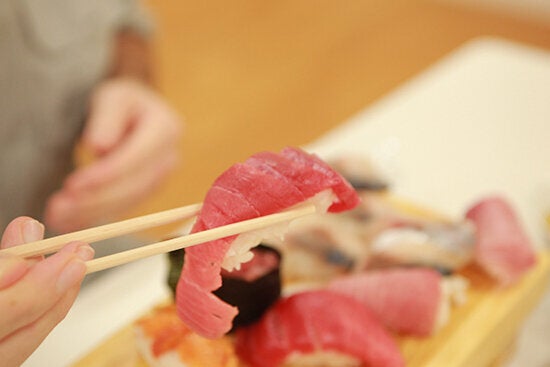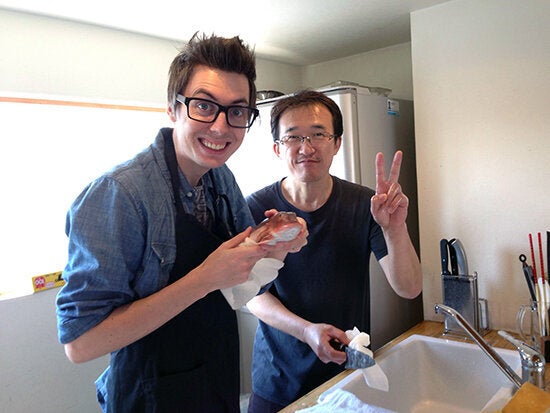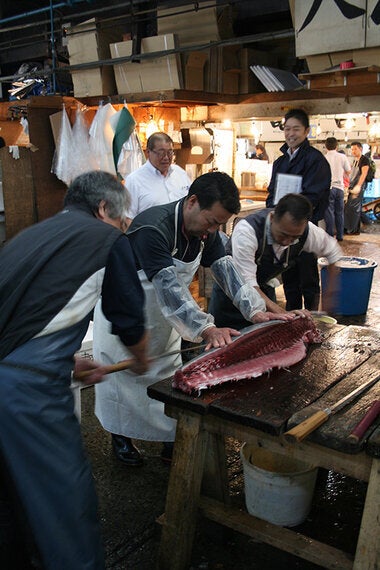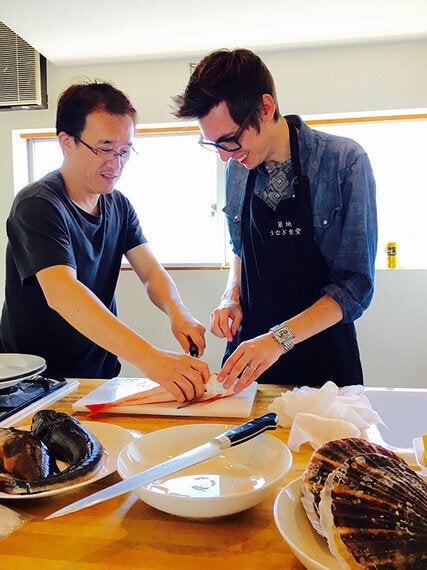As I finish another mediocre London sushi lunch that I've grabbed from beside the sandwiches, I find my mind transported back to Tokyo where the freshest and tastiest sushi imaginable filled a hole in my stomach and cemented a place in my mind as the best sushi I've ever eaten. But it's more amazing than that because it's also the best and only sushi I've ever made.
During a trip to Tokyo last year I spent a half day at Tsukij (the worlds largest fish market) with The Tsukij Sushi Workshop shopping for, buying, learning the secrets of and making a sushi banquet fit for a Japanese emperor or in this case a scrawny British mind-reader who is partial to a Maki or two.

We met Mr Morita a sushi master who has working with the market for more than 10 years and Tsubasa, his super friendly translator by the nearest subway station and went straight to the outer market to search out some fresh wasabi before going deep into the heart of inner market. Mr Morita and his team created the experience for tourists wanting to get an insider view of the chaotic market and to showcase the whole process of preparing sushi from procurement to presentation.
We quickly learn that every part of sushi creation is about context and art, everything has a history but things are in a constant flux. For example deciding which fish to buy is seasonal and regional but this isn't just about something being good in the spring and not the summer, this is about mini-seasons which can be as short as a few weeks. On top of that depending on the season the fish name and flavour can completely change. Luckily Mr Morita is on hand to show us what we should buy, what we should look for and in the chaos of the market he keeps us safe from the electric carts that zoom around transporting fish and just about avoiding tourists who weren't smart enough to get an expert guide.

All our questions are answered with grace, warmth and intelligence. We are taught how to pick the best fish for sushi and sashimi, looking for a fish with bright clear eyes and a swollen stomach then getting involved by lifting a gill and looking for pink or red as a sign of a recent catch and feeling for firm flesh. We saw men with Game Of Thrones style swords carving up a fresh tuna the size of a cow, and others taking a power saw to a frozen one. Our sushi master found some fish still swimming around a small tank and picked out the best of the bunch before we were shown a traditional Japanese technique of cutting the fish's head (not quite Game Of Thrones style) before placing a rod in the spinal cord to keep the fish as fresh as possible. Little did we know that less than 3 hours later we'd be eating that yellowtail and the squeamish noises from its death became mmm's and ahhh's of tasty delight.

After our time in the inner market our tiny group headed to the small classroom and kitchen just moments away, we change our shoes to slippers and are given a true master-class in how to prepare our sushi. With Mr Morita first showing us how it should be done. He expertly puts his sushi knife (which has been handed down in his family for generations) in our hands and shows us the easiest way to get skin off a fish I've ever seen. Taking the sharp blade of the specialist knife, I made a small cut into the fish, then literally shook it as the skin peeled off like butter. From this we were show the san-mai-oroshi, three-piece cut and go-mai-oroshi, five-piece cut method which have us slicing the middle section and separating it from the two side flaps of the fish.

We ground the fresh wasabi down on a shark skin grinder as the Tsukij Sushi Workshop team call to a nearby rice specialist who turn up with the best Japanese sushi rice, seasoned with vinegar, salt, sugar and rice wine while we're taught the basics of making our own sushi lunch. We start with wet hands, getting them as cold as possible (the colder the hands the better the sushi, in fact some studies have shown that true sushi masters can lower their body temperature while making sushi!) we clap our wet palms to get the excess water off before picking up a small handful of rice. It's gently placed in the cupped palm and shaped with two fingers before the fish goes on top of it. The secret lies in not squeezing the rice but sort of slapping it so the rice sticks together but doesn't push together loosing any of the air between it. It's those air gaps which helps make the sushi melt in the mouth delicious.
Before we know it there's a platter of different types of sushi and sashimi in front of us, far too much for a lunch if I'm honest. Its full of the freshest flavours, expert skills, care, love and taste. Even my own amateur attempts were better than the high street stuff we get back in the UK. No sushi can come close to this. The experience remains in my mind as one of the most unique, wonderful and traditional of my time in Japan. I felt honoured to spend some time with the Tsukij Sushi Workshop and will never look at sushi in the same way again.
Chris travelled to Japan with Inside Japan Tours and took part in the Tsukiji Market Sushi Workshop.